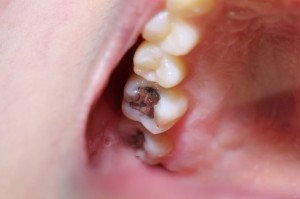 The mouth naturally contains various elements including saliva, plaque, calculus and many types of bacteria. Some bacteria are beneficial as they help control the destructive bacteria. Other strains like Streptococcus mutan contribute to tooth decay by consuming simple sugars and converting them into an acidic plague. Dental plaque is a sticky film of bacteria that forms on your teeth soon after eating or drinking sugary substances.
The mouth naturally contains various elements including saliva, plaque, calculus and many types of bacteria. Some bacteria are beneficial as they help control the destructive bacteria. Other strains like Streptococcus mutan contribute to tooth decay by consuming simple sugars and converting them into an acidic plague. Dental plaque is a sticky film of bacteria that forms on your teeth soon after eating or drinking sugary substances.
When plaque sticks to the teeth, the acid produced progressively attacks the minerals in your teeth in a process called demineralization. If you neglect to brush and floss as often as you should, plaque keeps growing and becomes hard and difficult to remove, forming a gateway for the formation of cavities. As more sugars are consumed, the acids produced continue to eat their way into the enamel to the inside part of the tooth leading to tooth decay.
Stages of Tooth Decay
The first sign of tooth decay is seen as a chalky white spot on the teeth. At this stage, the tooth can reverse the damage with the help of fluorides and minerals in saliva. When the decay process progresses and the enamel surface is broken, the tooth can longer repair itself. The tooth decay process weakens and destroys the tooth enamel leading to the development of tiny openings or holes. There is a need for the cavity to be cleaned out and restored by a dentist.
Over time, if these cavities are not treated, they get larger and allow the bacteria and acid to reach the inner tooth material (pulp) that contains nerves and blood vessels. The tooth’s pulp is affected by the bacteria causing it to swell and lead to problems like extreme tooth aches, infection, inflammation or tooth loss. At this stage, a dentist may recommend a root canal procedure to remove the tooth decay. If the tooth is severely damaged beyond repair, it may need to be removed and replaced with a denture, bridge or implant.
Preventing Teeth Cavities
Any part of the teeth is at risk of getting decay; however, the biting surfaces and the surfaces of the teeth are more likely to have food trapped between them hence being attacked by plaque acids. It is important to brush regularly, floss daily and visit your dentist periodically for professional cleanings to remove plaque that can’t be reached with your toothbrush or floss. Dental check-ups will also help to identify tooth decay and other problems in their early stages. Placing a dental sealant over your molars and premolars is another great way of protecting your teeth against acids and bacteria. Sealants can last up to 10 years without the need of replacement but need to be checked regularly to ensure they are intact.
The use of fluoridated toothpaste and mouthwash can prevent and replace the mineral loss in tooth enamel as well as kill bacteria that cause plaque. Chewing sugarless gums containing xylitol also prevents decay by stopping acid production, decreasing bacteria and enhancing the remineralization of teeth.
You can also reduce the number of bacteria in the mouth by limiting snack time to a few times a day. Snacking all day will cause the teeth to be on a constant acid attack. Eating meals that are rich in fiber can aid in increased saliva production which contains minerals that fight against tooth decay.
